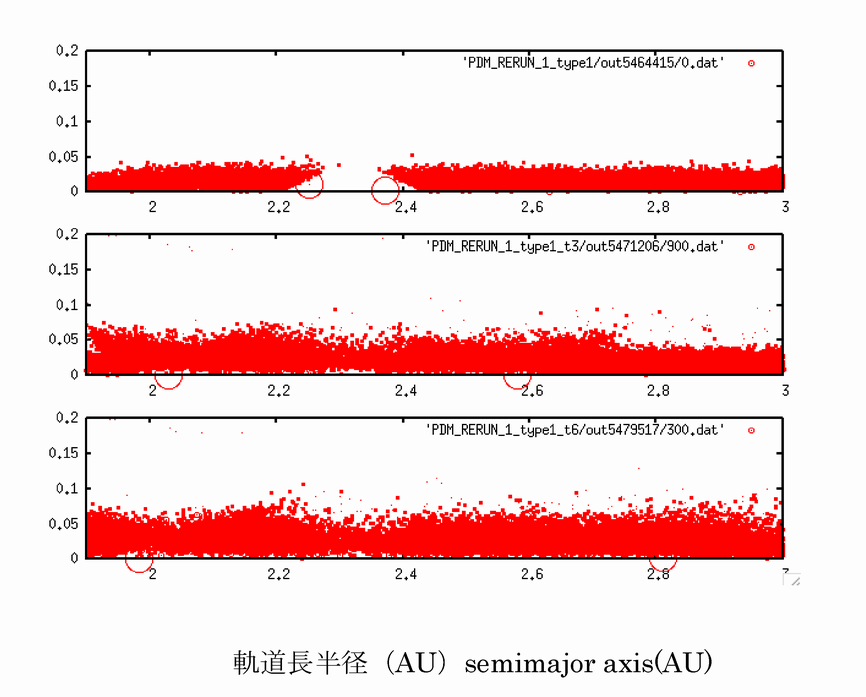Large Scale N-body simulation of Planet Formation : Effect of Fragmentation of Planetesimals
JAXA Supercomputer System Annual Report April 2016-March 2017
Report Number: R16E0061
- Responsible Representative: Junko Kominami(okyo Institute of Technology)
- Contact Information: Masaki Fujimoto(fujimoto.masaki@jaxa.jp)
- Members: Junko Kominami
- Subject Category: Space(Space science)
Abstract
Planets are thought to be formed from dust in protoplanetary disks. However, so far, we have not succeeded to reproduce even our Solar system. I am carrying out N-body simulation in order to clarify how the planetary system was formed.
Goal
When planetesimals collide with each other, fragments should be formed. Since if such fragments are included in the N-body simulations, the number of N increases and the simulation becomes heavy. That is why such large scale simulations was not carried out in the past. We included the fragmentation of the planetesimals and the protoplanets and carried out more realistic N-body simulations then ever.
Objective
By including enough number of planetsimals in the simulation, and the fragments, I would like to see if the protoplanet moves outward overcoming the inward type-I migration.
References and Links
N/A
Use of the Supercomputer
We developed a code called Kninja which is a parallelized N-body code for planet formation using supercomputer K. In Kominami et al. (2016), we showed that a protoplanet moves outward in the disk and stops after a while when enough number of planetsimals were included. I changed the force calculation part so that the code can be used for SORA-MA.The effect of fragmentation was added in the code.
Necessity of the Supercomputer
So far, number of particles we could calculate for N-body simulation was about 30 thousand even if special purpose accelerater called GRAPE was used. However, in order to express the inward and outward movement of the bodies, wider disk and larger number of particles (about 100 thousand particles) become necessary. We need to parallelize the code and use super computer.
Achievements of the Year
As for the initial condition, we used that of the second stage simulation in Kominami et al. (2016). We followed Kominami et al. (2005) for including the effect of gas drag and type-I migration. In order to see the effect of increase of number of bodies (N), we used a simplified fragmentation model. The gas drag damps the random velocity of the smaller bodies more easily. Such small bodies(fragments and small planetesimals) help the protoplanet move outward by planetesimal driven migration. When only perfect accretion was assumed, the planetesimals residing right behind (outer side of the protoplanet) grows. However, when fragmentation is considered, almost always small bodies reside right outside the protoplanet. One of the main criteria for the planetesimal driven migration to take place is the mass ratio of the protoplanet to the planetesimal has to be more than about 100. While the assumption of perfect accretion let the planetesimals grow to the size that the criteria breaks down, the fragmentation helps the outer migration.

Fig.1:Snapshots of random velocity vs the semimajor axis. Top panel is the initial state, middle panel is t=320000 years and the bottom one is t=640000 years. The outer protoplanet continues moving outward.
Publications
Presentations
1) Japan-Germany Planet Disk Workshop
2) JpGU
Computational Information
- Parallelization Methods: Hybrid Parallelization
- Process Parallelization Methods: MPI
- Thread Parallelization Methods: OpenMP
- Number of Processes: 168
- Number of Threads per Process: 32
- Number of Nodes Used: 168
- Elapsed Time per Case (Hours): 60
- Number of Cases: 3
Resources Used
Total Amount of Virtual Cost(Yen): 424,833
Breakdown List by Resources
| System Name | Amount of Core Time(core x hours) | Virtual Cost(Yen) |
|---|---|---|
| SORA-MA | 258,202.17 | 420,950 |
| SORA-PP | 0.03 | 0 |
| SORA-LM | 0.00 | 0 |
| SORA-TPP | 0.00 | 0 |
| File System Name | Storage assigned(GiB) | Virtual Cost(Yen) |
|---|---|---|
| /home | 4.77 | 17 |
| /data | 47.68 | 179 |
| /ltmp | 976.56 | 3,684 |
| Archiving System Name | Storage used(TiB) | Virtual Cost(Yen) |
|---|---|---|
| J-SPACE | 0.00 | 0 |
Note: Virtual Cost=amount of cost, using the unit price list of JAXA Facility Utilization program(2016)
JAXA Supercomputer System Annual Report April 2016-March 2017


